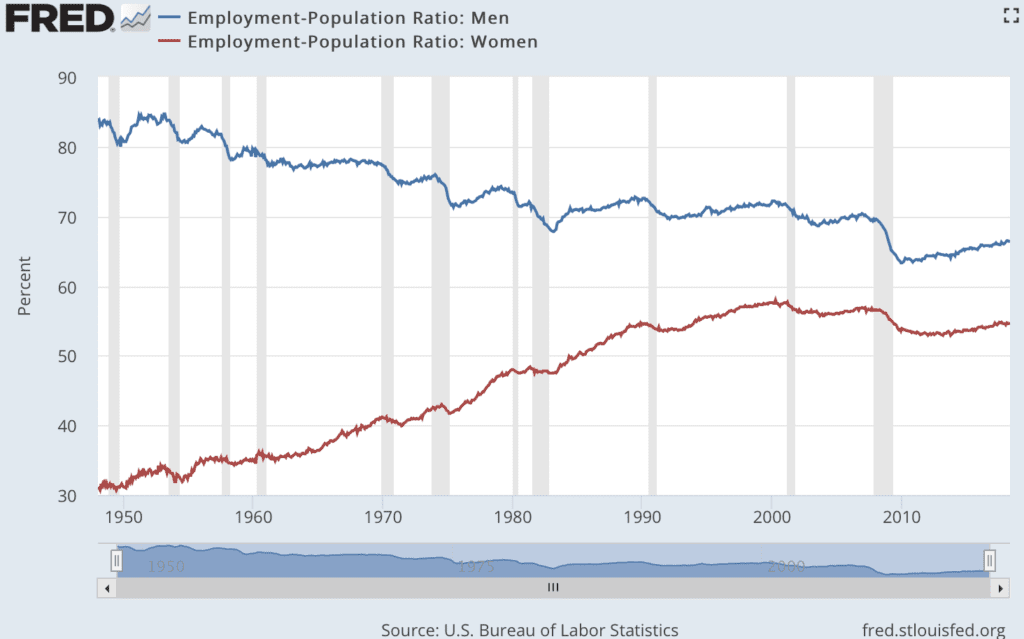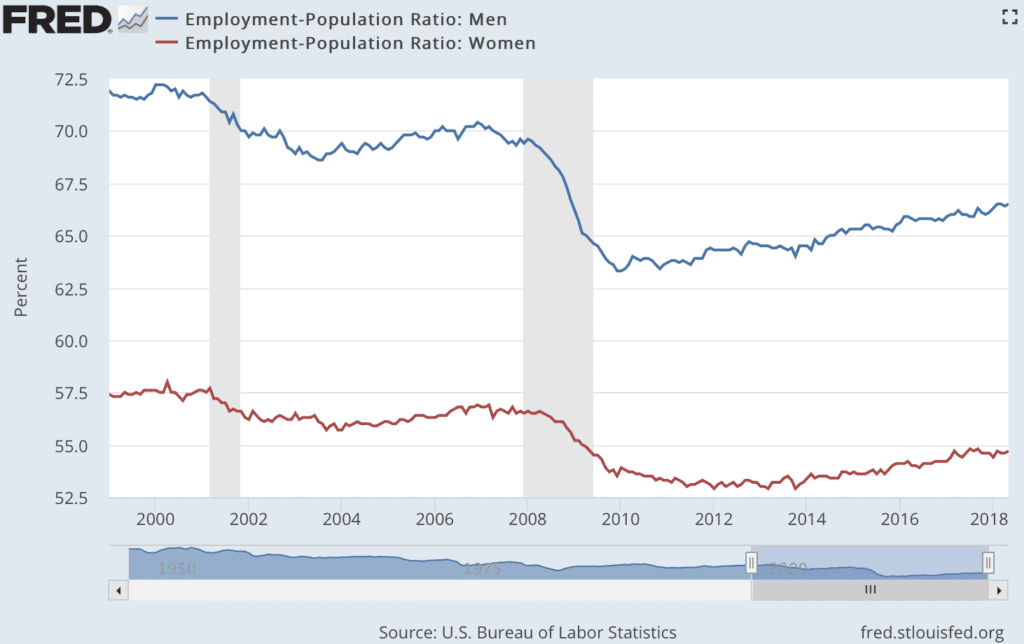Dean Baker points to this column, where Gregory Mankiw writes:
With unemployment at 3.8 percent, its lowest level in many years, the labor market seems healthy. But that number hides a perplexing anomaly: The percentage of men who are neither working nor looking for work has risen substantially over the past several decades. . . . This last group is ignored when calculating the unemployment rate. . . . The data show some striking changes over time. Among women, the share out of the labor force has fallen from 66 percent in 1950 to 43 percent today. . . . Men, however, exhibit the opposite long-term trend. In 1950, 14 percent of men were out of the labor force. Today, that figure stands at 31 percent.
Mankiw goes on to look at some subsets of the male population:
Consider prime-age men, those from the ages of 25 to 54. These men are generally well past their schooling and well before their retirement. . . . In 1950, only 4 percent of prime-age men were not working or looking for work. Today, that figure is 11 percent.
Wow. That is pretty stunning. Mankiw continues:
Why has that number nearly tripled? . . . One likely hypothesis, discussed in a recent paper by the economists Katharine G. Abraham and Melissa S. Kearney, is that the rise in nonparticipation is related to declining opportunities for those with low levels of education. . . .
So what’s the problem? Baker writes:
We’ll get to the explanations in a moment, but the biggest problem with explaining the drop in labor force participation among men as a problem with men is that since 2000, there has been a drop in labor force participation among prime-age women also. In we take the May data, the employment to population ratio (EPOP) for prime-age women stood at 72.4 percent.[1] . . . the drop against the 2000 peak of 74.5 percent is more than two full percentage points. That is less of a fall than the drop in EPOPs among prime men since 2000 of 3.2 percentage points, but it is a large enough decline that it deserves some explanation. In fact, the drop looks even worse when we look by education and in more narrow age categories. In a paper last year that compared EPOPs in the first seven months of 2017 with 2000, Brian Dew found there were considerable sharper declines for less-educated women in the age groups from 35 to 44 and 45 to 54, than for men with the same levels of education. The EPOP for women between the ages of 35 and 44 with a high school degree or less fell by 9.7 percentage points. The corresponding drop for men in this age group was just 3.4 percentage points. The EPOP for women with a high school degree or less between the ages of 45 and 54 fell by 6.7 percentage points. For men, the drop was 3.3 percentage points. Only with the youngest prime-age bracket, ages 25 to 34, did less educated men see a larger falloff in EPOPs than women, 8.2 percentage points for men compared to 6.9 percentage points for women. Looking at these data, it is a bit hard to understand economists’ obsession with explaining the drop in EPOPs for men. . . .
Now I was curious. I’m not experienced working with such data so I did a quick google search and found this page which makes graphs for the employment-to-population ratio for men and women.
Here’s the time series that Mankiw talked about: the decline for men and rise for women since 1950:

Now let’s focus on that last period since 1999:

I wasn’t able to easily grab the breakdowns by age. Overall, though, I see Baker’s point: In the 2008-2009 recession, employment dropped a lot more for men than for women, but then in the long recovery, the rebound was much greater for men. So if you want to ask, “Why aren’t so many people working?”, I agree with Baker that it seems to be a mistake to focus on men and not look at what’s happening with women too. This does not mean that Mankiw’s piece is so bad—there’s not room to cover everything in a newspaper article.
The narrative of the crisis among men
One thing that did bother me, though, was the way in which Mankiw’s story fits all too comfortably into the media narrative about the decline of men. It reminded me of the discussion we had a couple years ago about trends in mortality of middle-aged white Americans. This had been widely reported as yet another misfortune happening to men, but it turned out when you break up the data that the mortality rate was decreasing for white men in the age group in question; it was the women (in particular, women in the south) whose death rates were going up.